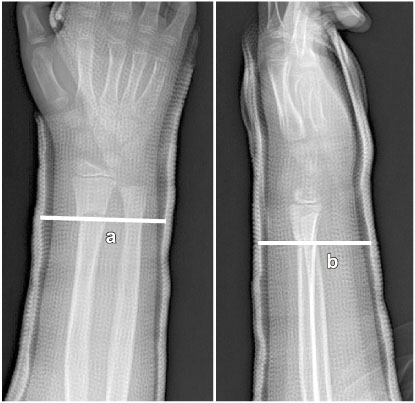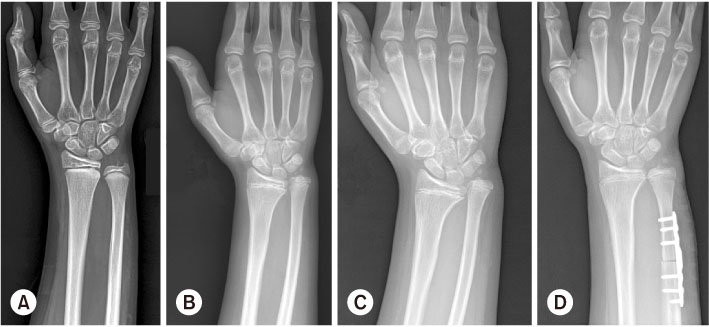Articles
- Page Path
- HOME > J Musculoskelet Trauma > Volume 34(2); 2021 > Article
- Review Article Pediatric Fractures around the Wrist
- Gihun Kim, Kun-Bo Park
-
Journal of Musculoskeletal Trauma 2021;34(2):80-86.
DOI: https://doi.org/10.12671/jkfs.2021.34.2.80
Published online: April 30, 2021

- 1,171 Views
- 23 Download
- 0 Crossref
- 0 Scopus
Abstract
Fractures around the wrist are the third most common fracture among all pediatric fractures. Furthermore, distal radius fractures, a type of wrist fracture, are the most common fractures in children. Understanding pediatric fractures around the wrist is very important considering their prevalence. There is a specific belief that pediatric fractures can heal easily because of remodeling, but not all fractures can heal without proper treatment. Complications such as growth problems, nonunion can occur if the fracture is not treated properly. This paper reviewed recent articles about distal radius fractures, Galeazzi-equivalent fractures, and carpal bone fractures, including scaphoid fractures in children and adolescents. Successful treatment can be achieved without complications when an accurate diagnosis and proper non-surgical or surgical treatment are performed based on this article.
Published online Apr 23, 2021.
https://doi.org/10.12671/jkfs.2021.34.2.80
Pediatric Fractures around the Wrist
 , M.D.
and Kun-Bo Park
, M.D.
and Kun-Bo Park , M.D.
, M.D.
Abstract
Fractures around the wrist are the third most common fracture among all pediatric fractures. Furthermore, distal radius fractures, a type of wrist fracture, are the most common fractures in children. Understanding pediatric fractures around the wrist is very important considering their prevalence. There is a specific belief that pediatric fractures can heal easily because of remodeling, but not all fractures can heal without proper treatment. Complications such as growth problems, nonunion can occur if the fracture is not treated properly. This paper reviewed recent articles about distal radius fractures, Galeazzi-equivalent fractures, and carpal bone fractures, including scaphoid fractures in children and adolescents. Successful treatment can be achieved without complications when an accurate diagnosis and proper non-surgical or surgical treatment are performed based on this article.
Fig. 1
Manual reduction of a displaced distal radius fracture (A → B → C → D). The dorsally displaced distal bone fragment was extended and pulled until the distal bone fragment's dorsal fracture surface contacted the dorsal fracture surface of the proximal bone fragment and was then bent to the palmar side to reduce.
Fig. 3
(A) Distal radius physeal fracture swith Salter–Harris type I. (B) After eight months, the physeal gap was narrowed, and physeal arrest is suspected. (C) After one year nine months, the ulnar was longer than the radius due to physeal arrest of the distal radius physis (ulnar impaction). (D) Ulnar shortening was performed. The residual growth of the distal ulnar bone was expected to be about 1 cm. Complete epiphysiodesis of the distal radial and ulnar growth plate was performed to prevent further deformity.
Fig. 4
Galeazzi fracture (A, B) and Galeazzi-equivalent fracture (C, D). Unlike a Galeazzi fracture-dislocation, the distal radio-ulnar joint is preserved in the Galeazzi-equivalent fracture.
Fig. 5
A 15-year-old boy's scaphoid fracture (A) was treated by percutaneous screw fixation (B). The scaphoid nonunion (C) was observed six months after surgery. There was no evidence of bony sclerosis, necrosis, or cyst on magnetic resonance imaging (D), and the subtle bony union was noted on the medial side. Additional cast fixation was performed for six weeks, and then complete healing (E) was observed.
Financial support:None.
Conflict of interests:None.
References
-
Shah NS, Buzas D, Zinberg EM. Epidemiologic dynamics contributing to pediatric wrist fractures in the United States. Hand(NY) 2015;10:266–271.
-
-
Schoenecker JG, Bae DS. Fractures of the distal radius and ulna. In: Flynn JM, Skaggs DL, Waters PM, editors. Rockwood and Wilkins' fractures in children. 8th ed. Philadelphia: Wolters Kluwer Health; 2015. pp. 349-412.
-
-
Egol KA, Koval KJ, Zuckerman JD. In: Handbook of fractures. 4th ed. Philadelphia: Lippincott, Williams & Wilkins; 2010.
-
-
Rodríguez-Merchán EC. Pediatric fractures of the forearm. Clin Orthop Relat Res 2005;(432):65–72.
-
- Related articles

 E-submission
E-submission KOTA
KOTA TOTA
TOTA TOTS
TOTS






 Cite
Cite

